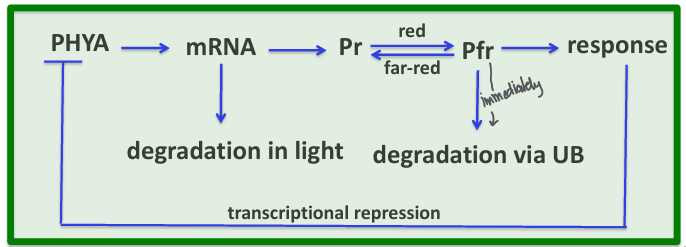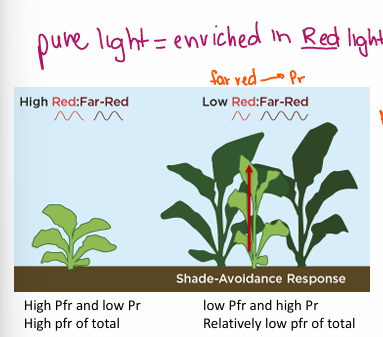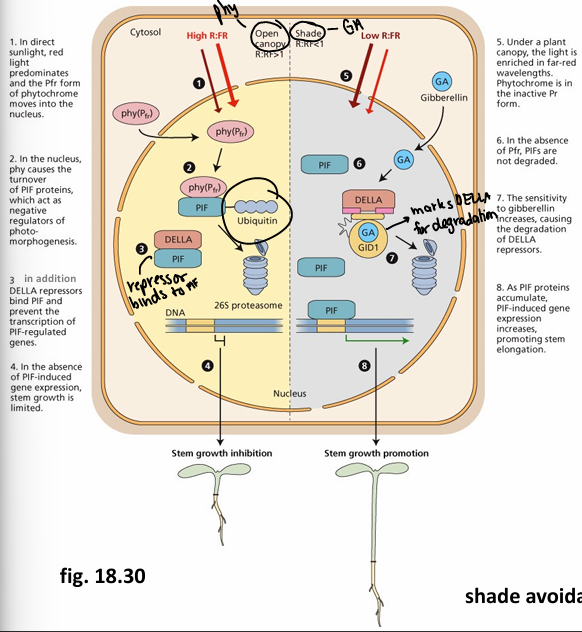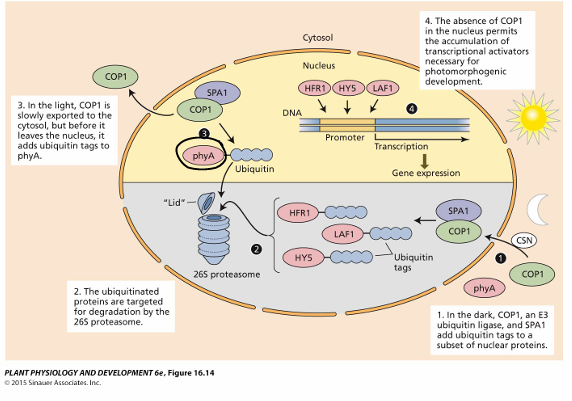Plant phys exam: 7 responses to Light
1/43
There's no tags or description
Looks like no tags are added yet.
Name | Mastery | Learn | Test | Matching | Spaced |
|---|
No study sessions yet.
44 Terms
What is photomorphogenesis?
light induced phenotypic changes distinct from photosynthesis
What changes happen with varying light quality?
stem elongation rates, leaf shape, surface area, time to flowering number of leaf hairs etc.

Compare and contrast the differences between light and dark grown seedlings
light: cotyledons open, short/thick stem, apical hooks open, direction of growth determined by light
dark: stem elongates rapidly, leaves don’t grow/expand, root growth is inhibited, direction of growth determined by gravity
What is the benefit of sunlight?
regulates cellular response (guard cell opening)
provides directional and nondirectional cues for growth (solar tracking)
regulates aspects of development (flowering/circadian rhythms)
Plants can perceive the spectral ___________of light in its environment
quality and quantity
What are the types of photoreceptors in plants?
A. Red Light Photoreceptors •
phytochromes (PHYA-E)-photomorphogenesis
B. Blue Light Photoreceptors
Cryptochromes (CRY1 and CRY2)- photomorphogenesis
phototropins (PHOT1 and PHOT2) – phototropism, guard cell opening, chloroplast movements
Zeitlupe (ZTL) – day length perception/circadian rhythms
C. UV Photoreceptors
UV Resistance Locus 8 (UVR8) - tends to inhibit elongation and counteract the shade-avoidance responses mediated by phytochrome
_____ are involved in lots of morphological changes. Give examples
phytochromes
seed germination, flowering, inhibin of stem elongation, leaf unfolding during de-etiolation, shade avoidance responses in “sun” plants
How does seed germination relate to light intensity.
red light promotes germination
far red light immediately following red light: inhibits germination
seed germination exhibits “far-red photo reversibility
Seed germination experiment
Last light treatment determines outcome
Red light – germination
Far red light – no germination

What are the 2 forms of photoconvertible phytochromes?
Pr : red absorbing form (650-680 nm) – absorption converts it to Pfr form
Pfr : far-red absorbing form (710-740 nm) – absorption converts it to Pr form
Phytochrome is synthesized in Pr form (dark grown tissues- only have Pr form)
In darkness: Pfr slowly reverts to Pr form

What is the absorbance spectra of the phytochromes?
Maximum Absorbance:
Pr = 666 nm
Pfr = 730 nm
** never have 100% of one form due to the overlap in the absorption spectra

What is the active form of phytochrome?
Pfr
able to promote/inhibit a response
Example:
Pfr promotes flowering in plants that respond to short nights (called long day plants)
Pfr inhibits flowering in plants that respond to long nights (called short day plants)
Describe phytochromes
they are homodimers of 2 identical subunits
homodimer: 2 of the same polypeptides
What is each phytochrome subunit made of?
chromophore (light absorption)
apoprotein (chromophore binding site) with hinge region= mediates conformational changes in protein shape

What happens in the absorption of red light?
1. conformational change via hinge region
2. exposes nuclear localization signal
3. Pfr form brings about large global changes in transcription

What rapid cellular responses does phytochrome cause?
activation of ion channels… changes in membrane potential
What longer slower changes does phytochrome mediate?
i.e. Flowering, germination, etc.
Transcriptional regulation
In dark, phytochrome remains outside the nucleus
Under white light (or red light-move into nucleus)
Describe the types of multigene family photochromes are encoded by
Type I phytochrome: PHY A
Type II phytochrome: PHY B-E
Dark grown seedlings: 23X more phytochrome than in light grown seedling
85% Type I: 15% Type II
Massive amounts of PHYA in DG tissues
Light grown seedlings: less total phytochrome present than in dark grown seedling & type II is more abundant
5% Type I: 95% Type II
Massive loss of PHYA in light

What factors influence the abundance of PHYA?
1. Darkness promotes transcription of PHYA mRNA (phytochrome is synthesized in Pr form)
2. Levels of PHYA protein regulated by 3 factors
A. mRNA degradation in light
B. proteolysis of PHYA Pfr protein by ubiquitin mediated degradation • PHYA has a PEST sequence (pro glu ser thr)
C-terminal end of protein has UB site C. PHYA Pfr represses transcription of PHYA gene
some proteins are very stable while others are not
Describe type II phytochromes.
1. transcription not regulated by light/dark
2. more stable in light (degraded more slowly, no pest sequence)
3. lower transcription rates
What is the result of a high concentration of PhyA in dark grown tissues?
an adaptation for maximized sensitivity to miniscule amounts of light
What are the 3 types of possible phytochrome responses?
based on the amount of light required to evoke the response
1. VLFR - very low fluence response
2. LFR - low fluence response
3. HIR – high fluence response
Define fluence
μmoles photons/M2
Define total fluence
μmoles photons/M2 x length of time (duration)
Define fluence rate
(μmoles/M2/Sec) # of photons absorbed per unit surface area per unit time
Describe the first response type of phytochrome
A. Initiated at very low fluences… Responses saturate at very low fluence (reach max @ low light (2 minutes of moonlight)
B. VLFR’s occur in dark-grown tissues
germination in some seeds
Initiate de-etiolation responses
C. VLFR’s are mediated by PHYA: high concentration of PhyA in DG tissues is an adaptation for maximized sensitivity to miniscule amounts of light
D. VLFR responses are NOT far-red photoreversible… phytochrome synthesized in Pr form
E. Obey Law of Reciprocity: reciprocal relationship between fluence rate and time
If response occurs under both conditions then the Law of Reciprocity holds
Describe the second response type of phytochrome
A. Initiated at low fluences (10,000X greater than VLFR) •
saturate at energy that is about 1% of the energy provided by 1 minute of full sunshine (0.6 seconds)
B. R/FR reversible (like the classic seed germination experiment) • red promotes response • far red light inhibits response
C. Law of Reciprocity holds (total amount of light)
D. Mediated by PhyB
What are some physiological responses that are LFRs?
seed germination (i.e. lettuce)
leaf unrolling
leaf movements
flowering (in some species)
Apical hook opening
Can a seed germinate if under the soil?
Light is enriched in far-red light
*** inhibits germination
Can a seed germinate under a plant canopy(shade)?
blue and red light is absorbed by surrounding plants for photosynthesis
so most light that reaches ground is enriched in far-red light
Far red light-prevents seed germination
BUT-
if you place far-red filter over leaf: ( i.e. block all FR light)
seed germinates, even if red light fluence is really low
blocking far-red light produces really large Pfr:Pr ratio
** ensures germination when close to surface of soil/in open sunlight/space
Describe the third response type of phytochrome
A. Require at least 100X more energy than LFR’s
B. Require prolonged/continuous light • remove light, response stops • law of reciprocity doesn’t apply/hold
C. Response is proportional to irradiance level (up to a maximum)
D. Responses saturate at very high fluences
E. Not R/FR reversible
What is the action spectra for HIP?
1. Light grown tissues - Ex. Inhibition of stem elongation
Red light (680 nm) evokes response (promotes inhibition)
PHYB mediated
As soon as you remove the red light-stems start elongating
What are physiological Responses that are HIRs
inhibition of hypocotyl elongation in mustard (Arabidopsis), lettuce and petunia • anthocyanin synthesis in some dicot species
induction of flowering in henbane
apical hook opening in lettuce
enlargement of cotyledons in mustard (Arabidopsis)
How can Phytochrome mediate a response?
1- a specific threshold level of Pfr causes a response • all or nothing type response
i.e. Seed germination
2- the amount of Pfr formed determines the magnitude of the response (more Pfr-bigger response)
Flowering or pigment synthesis
3- it is the ratio of Pr/Pfr that determines response: plants can use to ratios: Pfr/total phytochrome (Pr + Pfr) or Pr/Pfr
How does shade avoidance work in response to sun plants
monitoring the Pfr/total
red light is absorbed by leaves of canopy/ shade is enriched in far-red light
if “sun” plant is in shade, absorbs more far-red light than red light • converts more phytochrome to Pr form
Being in the shade changes Pfr:Ptotal ratio (decreases it) and stem begins to elongate

What do plants use the Pr:Pfr ratio for?
sense the change of seasons
At dawn, the phytochrome molecules in a leaf quickly convert to the active Pfr form,
In the dark, the Pfr form takes hours to slowly revert back to the Pr form.
By sensing the Pr/Pfr ratio at dawn, a plant can determine the length of the days/nights

Mechanism for inhibition and promotion of stem elongation in the light
Pfr decreases the synthesis of gibberellins in hypocotyls
In the shade-when Pfr levels are non-existent or low then GA has a greater effect on hypocotyls
shade avoidance is mediated by PHYB
Define PIFS
Phytochrome Interacting Factors

How is Photomorphogenic development (de-etiolation) regulated by ubiquitin mediated proteolysis in darkness:
COP1 is E3 ligase
RING domain E3 ligase
Highly conserved across organisms • SPA1 is required for its function
COP1 Functions as repressor for photomorphogenic development by degrading transcription factors that promote light mediated development

How is Photomorphogenic development (de-etiolation) regulated by ubiquitin mediated proteolysis in light:
E3 ligase moves out of nucleus
Transcription factors promote photomorphogenesis
PHYA Pfr moves into nucleus faster than COP1 leaves
PHYA is degraded by COP1 – decreasing the total PhyA protein levels
(remember PHYA levels decrease in light)